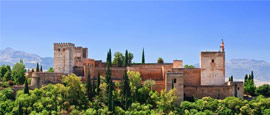Albaicín, which survived as a bustling Moorish quarter for several decades after the Christian reconquest of Granada in 1492, is a picturesque and atmospheric maze of narrow, twisting streets. The neighbouring district of Sacromonte is renowned for its cave dwellings, flamenco shows and amazing views of the Alhambra.
Things to see in Granada
Tourist offices
Address: Cárcel Baja, 3, Granada, 18001, Spain
Tel: +34 958 247 146.
Opening Hours:Mon-Fri 0900-1900, Sat 1000-1900, Sun 1000-1500. www.turgranada.es/en
The main tourist office in Granada offers local information, maps and guides as well as booking services for attractions, accommodation and transport. There's also a tourist office at City Hall on Plaza Carmen and at the Alhambra.
The Granada Card (Bono Turístico) (www.granadatur.com) gives admission to several major sights, including the Alhambra, cathedral, Capilla Real and La Cartuja and San Jerónimo monasteries, plus nine rides on city buses and a one-hour city tour on the tourist train. It's worth purchasing if you're stay in Granada a few days.
You can buy the Bono at the City Hall tourist information centre on Plaza del Carmen, the Sciences Park Museum on Avenida de la Ciencia, the Press Stand Chalo on Plaza Neuva and the Press Stand on Plaza del Campillo. It is also available online and over the telephone on +34 858 880 990.
Overlooking the city of Granada, the Alhambra is the most important and spectacular piece of Moorish architecture in Spain. Visitors can explore the Alcazaba, or citadel, which is the oldest remaining part of the complex, as well as the Alhambra Palace and the Generalife gardens. Be sure to book Alhambra admission tickets at least one week in advance.
The Capilla Real was commissioned by Granada's Christian conquerors, Fernando and Isabel, as their own burial place. Completed in 1521, it's a gorgeous gothic building next to a grand Cathedral of combined gothic and Renaissance styles. The monarchs died before the chapel was finished, but Charles V moved the bodies of his grandparents to the chapel once it was completed.
Hammam El Bañuelo doesn't look particularly remarkable from outside but it is the ruins of perhaps the best-preserved Arabic bathhouse in Spain. Inside visitors can view the beautiful architecture and learn how the bathhouse functioned, with its hot and cooling rooms and scenic courtyard.
For 10 years, Huerta de San Vicente was the summer home of Granada's beloved writer Federico Garcia Lorca. It is preserved exactly as it was in the days before he was arrested and assassinated in 1936 at the start of the Spanish Civil War. Exhibitions on Lorca's life and work are displayed throughout.
This late baroque building actually started life as a Roman cemetery, but the land was given to monks in 1506 so they could build a monastery. It wasn’t fully completed for another three centuries, but today it has a magnificent church and features plenty of wonderful artwork too.
San Jeronimo Monastery was the first monastery to be built after the conquest of the city by the Christians. Construction began in 1496, at Almoravid, now occupied by the hospital of San Juan de Dios. All the stones used for its construction were taken from the Arab gate of Elvira. The main attraction is the sacristy, but a beautiful alter created by Gil de Siloe and a riot of colourfully painted sculptures are worth exploring too.
Granada's most visited museum is this modern, interactive science park that is as genuinely fun for grown-ups as it is kids. Highlights include the Eureka Hall, where visitors can play with a gyroscope, and the epic Planetarium, which opens up the heavens. For younger visitors, the key attraction is the Exploration Hall which has plenty of hands-on entertainment for those aged 3-7.
This rather stark modern building is a real contrast to the historic architecture that defines much of Granada, but is worth a visit for the museum tucked away in its depths. Exploring everything from the environment and natural resources in the area to Andalucían communities, it’s one of the city’s best-kept secrets.
This impressive gothic-style building has been used as everything from a hospital for soldiers and pilgrims to a prison for the insane - even a treatment centre for venereal diseases. Today it houses the Rectorate and the Central Library of the University, and there are glorious gardens to explore as well as an art gallery with regularly changing exhibits.
Do you have any Feedback about this page?
© 2025 Columbus Travel Media Ltd. All rights reserved. No part of this site may be reproduced without our written permission, click here for information on Columbus Content Solutions.








 You know where
You know where